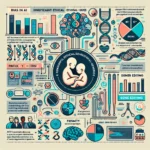The IELTS Reading section assesses your ability to understand complex texts and answer various question types. Today, we’ll focus on a topic that has gained significant attention in recent years: privacy issues with wearable technology. This subject has appeared in past IELTS exams and, given its relevance in our increasingly digital world, it’s likely to resurface in future tests. Let’s dive into a practice passage and questions to help you prepare for this potential topic.
 Privacy concerns with wearable devices
Privacy concerns with wearable devices
Practice Passage: The Privacy Dilemma of Wearable Tech
Text
Wearable technology has revolutionized how we monitor our health, fitness, and daily activities. From smartwatches to fitness trackers, these devices have become ubiquitous in modern society. However, as their popularity soars, so do concerns about the privacy implications of the vast amounts of personal data they collect.
Wearable devices gather an unprecedented level of intimate information about their users. Heart rate, sleep patterns, location data, and even mood indicators are just a few examples of the sensitive data these gadgets continuously record. While this information can provide valuable insights for users and healthcare providers, it also raises significant privacy concerns.
One primary issue is data security. The information collected by wearable devices is often stored in cloud servers, making it vulnerable to cyber attacks. In 2018, a major fitness tracking company suffered a data breach that exposed the personal information of 150 million users. This incident highlighted the potential risks of centralized data storage and the need for robust security measures.
Another concern is the potential misuse of data by companies. Many users are unaware of the extent to which their personal information may be shared with third parties. Some wearable tech companies have been criticized for selling user data to advertisers or using it for purposes not explicitly consented to by users. This practice raises questions about transparency and the ethical use of personal information.
The integration of wearable technology with other systems, such as healthcare providers or insurance companies, presents both opportunities and risks. While sharing health data with medical professionals can lead to better patient care, it also raises concerns about data privacy and potential discrimination. For instance, insurance companies might use data from wearable devices to adjust premiums or deny coverage based on an individual’s health metrics.
Governments and regulatory bodies are struggling to keep pace with the rapid advancement of wearable technology. Current privacy laws in many countries were not designed with these devices in mind, leaving gaps in protection for consumers. The European Union’s General Data Protection Regulation (GDPR) has set a precedent for stricter data protection, but many argue that more specific regulations are needed to address the unique challenges posed by wearable tech.
As wearable technology continues to evolve, striking a balance between innovation and privacy protection remains a critical challenge. Users, companies, and policymakers must work together to ensure that the benefits of these devices do not come at the cost of personal privacy. Increased transparency, stronger security measures, and more comprehensive regulations will be essential in addressing the privacy concerns associated with wearable technology.
Questions
-
Which of the following is NOT mentioned as a type of data collected by wearable devices?
A) Heart rate
B) Sleep patterns
C) Dietary habits
D) Location data -
According to the passage, how many users were affected by the data breach of a major fitness tracking company in 2018?
A) 15 million
B) 50 million
C) 100 million
D) 150 million -
The author suggests that the integration of wearable technology with healthcare systems is:
A) Entirely beneficial
B) Completely risky
C) Both opportunistic and potentially problematic
D) Not significant for patient care -
Which regulation is mentioned as setting a precedent for stricter data protection?
A) The US Privacy Act
B) The General Data Protection Regulation (GDPR)
C) The Health Insurance Portability and Accountability Act (HIPAA)
D) The California Consumer Privacy Act (CCPA) -
According to the passage, what is one way insurance companies might use data from wearable devices?
A) To provide free health advice
B) To adjust premiums
C) To promote healthy lifestyles
D) To develop new insurance products
6-10. Do the following statements agree with the information given in the passage?
Write TRUE if the statement agrees with the information
Write FALSE if the statement contradicts the information
Write NOT GIVEN if there is no information on this
-
Wearable devices can collect information about a user’s mood.
-
All users are fully aware of how their personal data is shared with third parties.
-
The GDPR provides complete protection for users of wearable technology.
-
Privacy laws in most countries were specifically designed for wearable technology.
-
The author believes that cooperation between users, companies, and policymakers is necessary to address privacy concerns.
Answers and Explanations
-
C) Dietary habits
Explanation: The passage mentions heart rate, sleep patterns, location data, and mood indicators as examples of data collected by wearable devices. Dietary habits are not mentioned in the text. -
D) 150 million
Explanation: The passage states, “In 2018, a major fitness tracking company suffered a data breach that exposed the personal information of 150 million users.” -
C) Both opportunistic and potentially problematic
Explanation: The passage notes that integrating wearable technology with healthcare systems presents “both opportunities and risks,” mentioning better patient care as an opportunity and data privacy concerns as a risk. -
B) The General Data Protection Regulation (GDPR)
Explanation: The text specifically mentions that “The European Union’s General Data Protection Regulation (GDPR) has set a precedent for stricter data protection.” -
B) To adjust premiums
Explanation: The passage states that “insurance companies might use data from wearable devices to adjust premiums or deny coverage based on an individual’s health metrics.” -
TRUE
Explanation: The passage mentions “mood indicators” as one of the types of data collected by wearable devices. -
FALSE
Explanation: The text states, “Many users are unaware of the extent to which their personal information may be shared with third parties.” -
NOT GIVEN
Explanation: While the GDPR is mentioned as setting a precedent for stricter data protection, the passage does not state whether it provides complete protection for wearable technology users. -
FALSE
Explanation: The passage states, “Current privacy laws in many countries were not designed with these devices in mind.” -
TRUE
Explanation: The author concludes by saying, “Users, companies, and policymakers must work together to ensure that the benefits of these devices do not come at the cost of personal privacy.”
Common Mistakes to Avoid
-
Overlooking key details: In questions like #1, it’s crucial to carefully check all options against the information provided in the text.
-
Misinterpreting numerical data: For questions like #2, make sure to read the numbers accurately and match them to the correct context.
-
Overgeneralizing statements: In questions like #3, avoid extreme interpretations and look for nuanced answers that reflect the complexity of the issue.
-
Confusing similar terms: Be careful not to mix up names of regulations or acts, as in question #4.
-
Making assumptions: For TRUE/FALSE/NOT GIVEN questions, base your answers solely on the information provided in the text, not on your general knowledge.
Key Vocabulary
- Ubiquitous (adjective): /juːˈbɪk.wɪ.təs/ – present, appearing, or found everywhere
- Intimate (adjective): /ˈɪn.tɪ.mət/ – private and personal
- Vulnerable (adjective): /ˈvʌl.nər.ə.bəl/ – able to be easily physically, emotionally, or mentally hurt, influenced, or attacked
- Misuse (noun): /mɪsˈjuːs/ – the wrong or improper use of something
- Discrimination (noun): /dɪˌskrɪm.ɪˈneɪ.ʃən/ – treating a person or group differently from other people or groups in an unfair way
- Precedent (noun): /ˈpres.ɪ.dənt/ – an action, situation, or decision that has already happened and can be used as a reason why a similar action or decision should be performed or made
Grammar Focus
Pay attention to the use of modal verbs in the passage, such as “might” and “can.” These are used to express possibility and ability:
- “Insurance companies might use data from wearable devices to adjust premiums…”
- “While this information can provide valuable insights for users and healthcare providers…”
Modal verbs are important in academic writing to express degrees of certainty and possibility. Practice using them in your own writing to add nuance to your statements.
Tips for IELTS Reading Success
-
Time management: Practice with timed exercises to improve your speed without sacrificing accuracy.
-
Skimming and scanning: Develop these skills to quickly locate relevant information in the text.
-
Vocabulary building: Regularly study academic and topic-specific vocabulary to improve your understanding of complex texts.
-
Practice various question types: Familiarize yourself with all IELTS Reading question formats to be prepared for any challenge.
-
Read actively: Engage with the text by highlighting key points and making mental summaries as you read.
-
Stay informed: Keep up with current affairs and technological trends to build background knowledge that can aid comprehension.
By focusing on these areas and practicing regularly with passages like the one above, you’ll be well-prepared to tackle privacy and technology topics in your IELTS Reading test. Remember, understanding complex issues like privacy in wearable technology not only helps in your exam but also prepares you for navigating the challenges of protecting digital privacy in your daily life.
Keep practicing, and don’t hesitate to explore more about the social implications of increasing use of wearable technology to broaden your understanding of this important topic. Good luck with your IELTS preparation!


